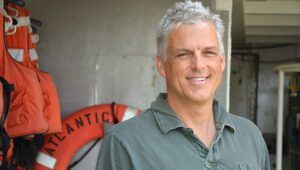Oceanographer Recognized for Innovative Research

In the clear waters off the coast of Bermuda, Dr. Craig Carlson has spent decades investigating the invisible forces shaping the global carbon cycle: millions of bacteria in every drop of seawater, consuming carbon compounds dissolved into the ocean like sugar into tea. Dr. Carlson’s research linking how microbes interact with carbon in the ocean is now considered vital to understanding the global carbon cycle, and he is being honored with a major award from the leading professional organization for aquatic scientists.
The American Society for Limnology and Oceanography announced this week that Dr. Carlson, Professor of Microbial Oceanography at the University of California Santa Barbara and adjunct faculty at BIOS, is the 2015 recipient of the prestigious G. Evelyn Hutchinson award. The award “honors a limnologist or oceanographer who has made considerable contributions to knowledge, and whose future work promises a continued legacy of scientific excellence,” and will be presented at the Society’s annual conference in Granada, Spain this February.
Much of Carlson’s research has been conducted at BIOS’s Bermuda Atlantic Time-series Study (BATS) site, where BIOS scientists have collected physical, chemical and biological data for the past 25 years. Carlson first worked at BIOS as a volunteer intern in 1987, and was back within two years to begin fieldwork for his doctoral studies at the newly established BATS site. In 1996, he joined BIOS as a faculty member and helped lead the BATS program until 2001.
“BATS is a beautifully extended, extremely rich dataset that allow other oceanographers to place smaller more focused studies into a much larger and important context,” said Dr. Carlson, who uses a combination of genetic studies and analytical chemistry to identify the microbes in the water and the carbon compounds they are using. By sampling within the BATS program, Dr. Carlson could make observations about how microbial communities are linked to patterns in dissolved organic carbon and how both variable respond to changing forces like ocean mixing and temperature.
At the BATS site, Carlson and his colleagues discovered very regular patterns of dissolved organic carbon building up in surface waters, and then mixing downward into deeper waters. Likewise, they discovered distinct microbial communities thriving in surface waters, in deep waters, and certain groups of microbes that thrive seasonally.
When microbes consume carbon compounds in surface waters, that carbon may be transformed into carbon dioxide and return to our overburdened atmosphere. If that dissolved organic carbon escapes microbial consumption in the surface, some of it can be transported to the deep ocean and sequestered from the atmosphere for centuries depending on the study site. Thus, understanding how microbes respond to dissolved organic substrates at different depths and times in the ocean is critical for understanding the ocean’s role in the carbon cycle and climate change. These concepts extend to the larger global ocean but much of the basic proof of concept was formalized at BATS.
Dr. Carlson continues to conduct research at BIOS, where the BATS site gives unprecedented views into how the ocean changes over time, and where the Oceanic Microbial Observatory is dedicated to developing new methods for identifying marine microbes and their metabolisms. He commended the commitment and vision of his colleagues who run BATS and the Observatory for their dedication to maintaining the dataset every month, year in and year out.
“I am very honored to receive this award,” Carlson said, “and it is shared with the outstanding collaborators I’ve had at BIOS and working at BATS,” Carlson said.
